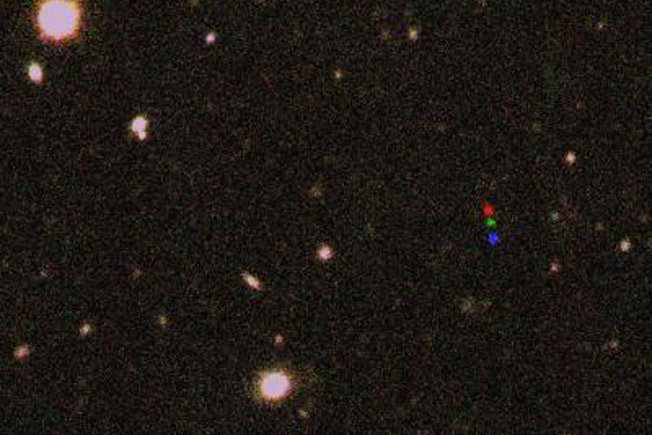.

This composite of three images shows the movement of 2012 VP113, informally named 'Biden.' The planet moved between each image, as shown by the red, green and blue dots.
.
It’s one of the biggest discoveries in modern astronomy – and they’ve dubbed it “Biden.”
Scientists have found a distant dwarf planet, one orbiting beyond what was previously thought to be the farthest reaches of our Solar System.
Officially named 2012 VP113, it’s “affectionally called” Biden, for the “VP” that’s in the planet’s formal name, a statement on the discovery said.
The vice president’s office did not return a request for comment.
Discovered by astronomers Scott Sheppard and Chadwick Trujillo, the planet is likely one of thousands of objects thought to make up what’s known as the “inner Oort cloud” at the furthest edge of the Solar System. The findings also suggest the presence of another far larger planet – one that’s perhaps 10 times the size of Earth.
“This is an extraordinary result that redefines our understanding of our Solar System,” said Linda Elkins-Tanton, director of the Carnegie Institution of Science’s Department of Terrestrial Magnetism.
Unlike the vice president, VP113 is no insider: at its closest point to the Sun, the planet still sits 80 times the distance of the Earth to the Sun, or 80 astronomical units (AU) away.
Biden, in fact, was discovered outside what are considered the three main parts of the Solar System: the rocky planets like Earthy that are close to the Sun; the gas giant planets that are further away; and the frozen objects that comprise the so-called “Kuiper belt,” a huge mass of rocks, metals and ice – including Pluto – that swirl around the Solar System beyond the orbit of Neptune.
.

In this orbit diagram, the Sun and terrestrial planets are at the center, the four giant planets (Jupiter, Saturn, Uranus and Neptune) are shown by purple solid circles and the Kuiper Belt is shown by the dotted light blue region. Sedna's orbit is shown in orange, and Biden's orbit is shown in red.
.
Outside that belt is what appears to be the edge of the Solar System, where another object, Sedna, was discovered in 2003. At the time, it was not clear whether Sedna was unique: while there’s a distinct boundary to our Solar System at 50 AU, Sedna maintained an orbit of 76 AU.
The discovery of Biden now shows that Sedna is not alone. Together, they make up two known members of the inner Oort cloud and also offer potential insight into how our Solar System came to be.
"The search for these distant inner Oort cloud objects beyond Sedna and 2012 VP113 should continue, as they could tell us a lot about how our Solar System formed and evolved," said Sheppard in a statement.
Sheppard and Trujillo first found Biden by using a new “Dark Energy Camera” on a huge telescope in Chile. They then determined its orbit by using another telescope, located at Carnegie’s Las Campanas Observatory, also in Chile.
The pair believes that as many as 900 other objects with orbits like Biden and Sedna are out there.
"Some of these inner Oort cloud objects could rival the size of Mars or even Earth. This is because many of the inner Oort cloud objects are so distant that even very large ones would be too faint to detect with current technology,” Sheppard said.
The discovery was scheduled to be published this week in the journal Nature.
Quelle: USNews
